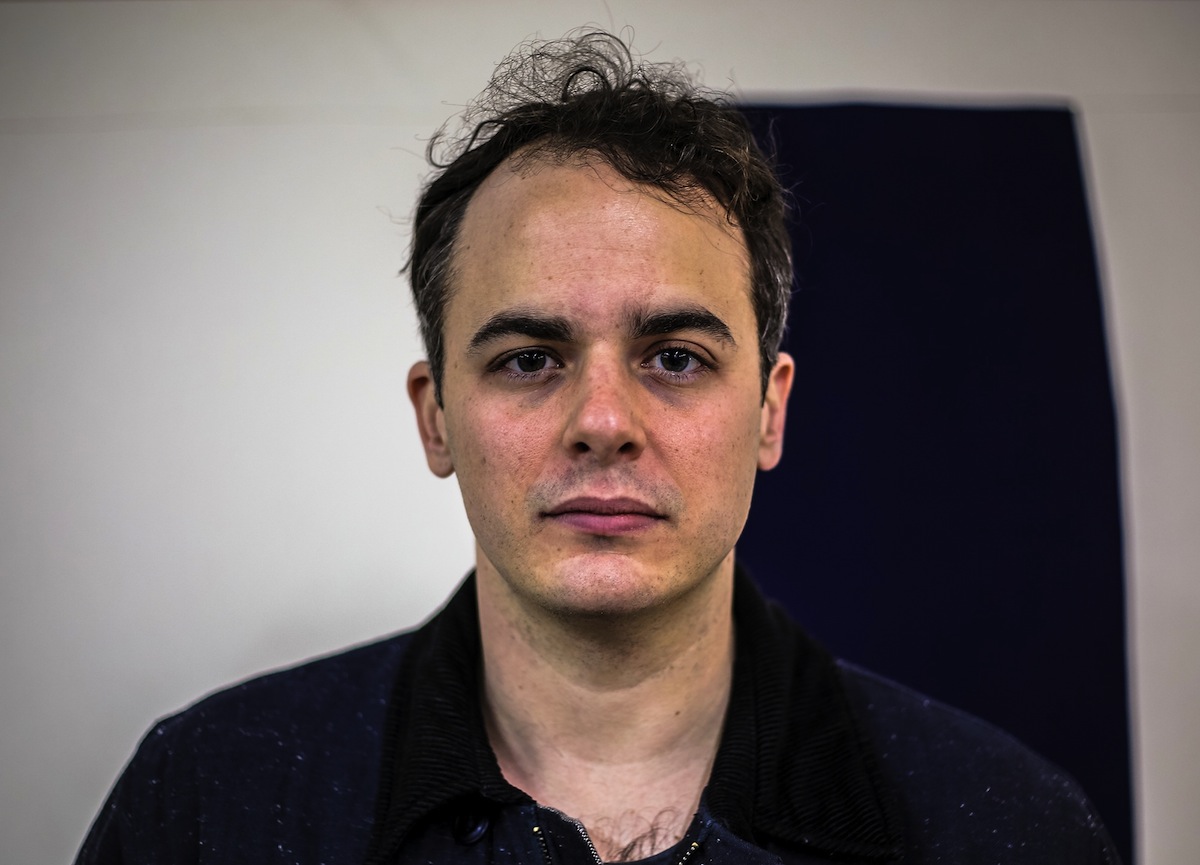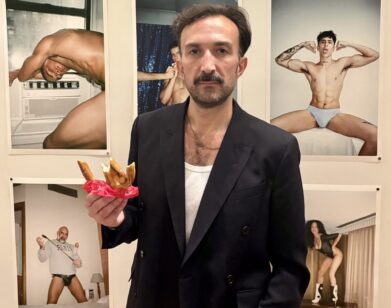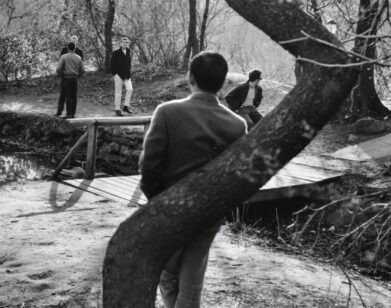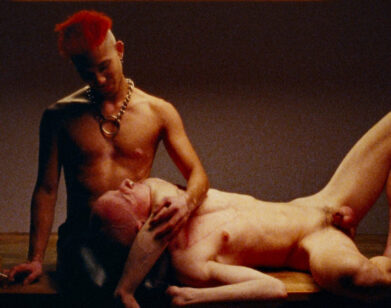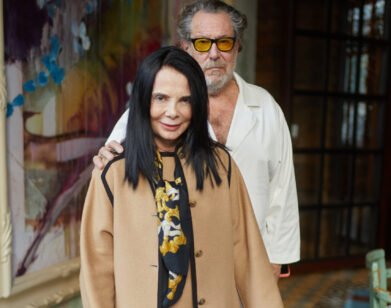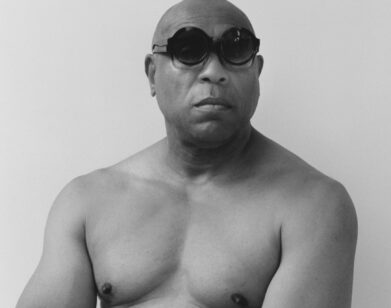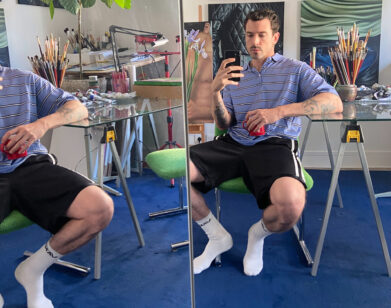Ethan Cook Spins a Yarn
Ethan Cook is a painter, but he doesn’t have any paint in his studio. His new exhibition, “Problem in Chair Not in Computer,” up now at American Contemporary, presents a strong body of work made up of hand-woven canvas pieces that he makes on a wooden loom in his Greenpoint studio—but he is not a weaver. Between the three “failed chair” sculptures in the show and the hand-woven canvases, Cook’s work presents failure as the ultimate artistic gesture.
But failure is relative. Alongside machine-made material, Cook’s hand-woven canvas pieces expose the human touch in the weave, the inconsistencies, the inability to make canvas in the same manner as the machine. We caught up with Cook last week.
ADAM O’REILLY: When I met you a few years ago, you were making dyed canvas pieces, these new works at American Contemporary have evolved from a similar exploration of materials. Tell me about how this body of work came about?
ETHAN COOK: I was making the dyed pieces up until a couple years ago—they were dyed and bleached pieces of canvas that were then stretched. I was changing what the canvas was as a material, the fiber of the canvas, instead of painting or marking on the canvas. In those I was changing what the canvas actually was, this led me to the next logical step, which is how canvas is made. It made me want to explore weaving—so I took a weaving class and learned to make canvas.
O’REILLY: And tell me about the decision to present the hand-woven canvas you make alongside the machine-made canvas.
COOK: I now see the loom as a canvas printer—as with a printer, there is error involved, those errors in the canvas become the gestures and the artist’s hand and mark making. I present the pieces I make on the loom sewn together with store bought canvas to highlight these tiny gestures that come out of the weaving process.
O’REILLY: In early iterations of this body of work, some of the hand-woven panels were made of different-colored canvas. Why the decision to leave color out of this exhibition?
COOK: I wanted the canvas that I make for these to be as close to store-bought canvas as possible; I’ve taken away the color, I use only cotton and linen, only plain weave on the loom, which is how canvas is traditionally made. You know, a lot of people like the blue pieces I was making from a year ago, which made me want to do them less. [laughs] But it’s really about trying to stick to my original concept for this work.
O’REILLY: Explain the title of the show and how it relates to the show, and maybe more literally, to the upside-down chair sculptures in the show.
COOK: “Problem in Chair Not in Computer,” or “PICNIC,” is a term used mainly by people who answer phones at tech call centers. It’s a polite acronym for “This person does not know what they are doing; it’s their problem not ours.” So it relates to the idea of the loom as a printer, the weaver as the user. But the title tied literarily in with the sculpture pieces, which are “failed chair” pieces. I had all of this studio plywood that I was using for tables that had become too warped to use. I couldn’t get rid of them in my studio building; they won’t take trash that big. So it was sort of a matter of finding something to do with it, something useful. When Donald Judd moved to Marfa, he needed furniture for all of his spaces, and the only material he could get out there was four-by-eight-foot sheets of plywood—and that’s why all that furniture was made of plywood. So in a similar way, it was out of necessity to get rid of this wood: but unfortunately, they didn’t really function well as chairs.
O’REILLY: Repetition has become a motif in the work. Three of the four canvas works are, from a distance, seemingly identical, and there are three chairs presented in a row.
COOK: In the show, there are three that are the same composition and the same colors. They each have two panels of the hand-woven canvas on them. By presenting two hand-woven pieces in each work, it’s the easiest way to present likeness and contrasts. It’s not about forms interacting in space, it more about presenting these materials as they are, seeing the natural contrast between. You can see it from piece to piece, but also within each piece.
O’REILLY: In this exhibition, you are also presenting the hand-woven pieces more indexically; in the past, the works had more dynamic compositions.
COOK: All of the hand-woven pieces stay the original width they are on the loom—so I see that work as an indexical presentation of their own creation. You can see each line over line, how the piece was made. Actually, the big piece in the back room in the show is not only the original width, but also, the original length of the hand-woven canvas. That is first time I have been able to do that. The other pieces are cut-down fragments.
O’REILLY: At that point it feels more like conceptual completion—very ideal.
COOK: Exactly, I want to move that direction in the next year, and I have some opportunities and bigger spaces to present the work. The loom can make canvas 48 inches by 10 yards long. That’s its max, but also one of my goals.
O’REILLY: What’s your relationship with the craft of weaving, and using a loom? Is it important to you?
COOK: For me, weaving is a means to an end—I started out painting, not weaving. I am not making woven structures or reference to the history of weaving. Earlier, when I said I see the loom as a printer, I literally just see it as a process to make canvas. A 3-D, canvas printer. [laughs]
“PROBLEM IN CHAIR NOT IN COMPUTER” IS ON VIEW NOW AT AMERICAN CONTEMPORARY.

